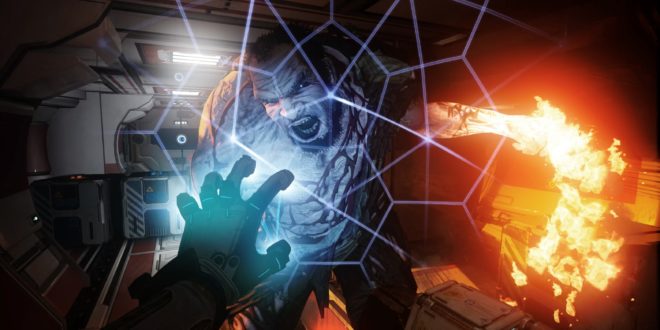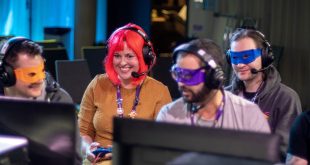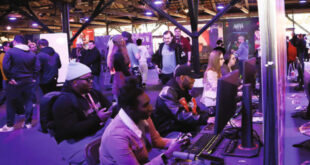In a market filled with shorter, more casual experiences, The Persistence was something of a success story for the PSVR. Releasing in 2018, the survival horror VR title was one of the few to offer a hardcore, eight-to-ten hour experience exclusively for Sony’s headset.
It was a success for developer Firesprite too. The Persistence was the Liverpool-based studio’s first IP, entirely self-published by the studio, and was warmly received by the press – clocking in at 78 on Metacritic, with critics regarding it as one of the best VR
experiences available at the time.
It’s a strong first showing for a studio that had previously worked on other studios’ properties, such as the augmented reality title The Playroom (as well as Playroom VR), and free to play Vita and mobile title, Run Sackboy Run! Still, it was a move that fitted with the philosophy the studio had taken towards these projects.

“We’ve done a lot of what I call ‘strategic projects’ where we partner up with big platform holders,” says Graeme Ankers, managing director of Firesprite, “and it’s generally about looking at new technology or things that are coming in the future. That’s a lot of what we do as a studio.”
With this in mind, Firesprite’s latest announcement seems to be a bit of a surprise. The Persistence will be coming in non-VR form to PC, PS4, Xbox One and Nintendo Switch this summer – with existing owners of the PSVR version receiving it for free as an update.
It’s an unexpected move from a studio known for experimenting with new technologies, but one that Ankers argues stays true to the studio’s core philosophies:
“The key drive for Firesprite is to really push and deliver something special, and do something slightly different. Even in going from VR to non-VR for Persistence, we still feel that we’re experimenting in bringing innovation and something new to the genre.”
PANCAKE MODE
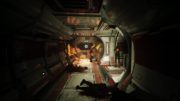
It’s certainly new to see a VR game being adapted for a non-VR platform. If anything, we’re more used to seeing movement in the opposite direction – such as with Skyrim and No Man’s Sky moving to VR, for instance.
Adapting The Persistence for flatscreen platforms (or “pancake mode,” as Firesprite calls it) brought a host of problems to development, both expected and unexpected – leading to a much more difficult process than had been initially anticipated.
“We were doing a lot of testing side by side,” notes Ankers, “even when we were developing the game for PlayStation VR. And it just seemed to really work, in every component of the game. Once we’d delivered the PlayStation VR experience, and we got some really lovely critical and commercial success from that, we then thought ‘well, why don’t we explore this on different platforms?’ And as optimistic developers, as we always are, we thought this would be really easy.
“Going from VR to non-VR, the whole design language of the game is very different. Even how you treat a user interface, or taking account for where the player is sat in the experience is very different. VR controls are very attached to look at systems that are played based on head tracking. So on PSVR we had something that was quite subtle, but we had a cursor that wrapped around the objects that you were looking at. So we’re changing that language completely moving to a flat screen version of the game, so there’s challenges around that, because you’re redesigning that system.”
Even simple things like the UI have to be changed drastically when adapting from VR. The Persistence’s upgrade system, for instance, is represented in a menu that takes advantage of the extra space allowed by VR, with the player being able to physically look around a large, sprawling menu. But once adapted for a flatscreen, suddenly this menu design became unmanageable, and had to be redesigned.
It isn’t all aesthetic changes either. The shift in platform meant that gameplay adjustments had to be made as well.
“We did a lot of work on the locomotion speeds on the Playstation VR version, adapting turning speeds to eliminate nausea and things like that. By default, the rotation speed in VR is incredibly quick. And that’s to bypass your own body’s response to turning – because if it’s slow enough for your body to recognise it, that’s where you get motion sickness. Because you recognise it as a turn and therefore your body thinks it should be turning, and it’s not. So it starts to think ‘oh my god, I’m poisoned’. It’s a travel sickness thing.”
We can vouch for that ourselves. The Persistence in VR offers players with stronger stomachs the option for slower turning speeds. We give it a go and need a lie down for about half an hour, before returning to appreciate the work the team put into protecting us weak-bellied folks. And these nausea-reducing efforts extended to the level design too.
“If you look at the way that the game is designed it’s quite subtle, you’ll notice that a lot of things are on a level. For example, there’s not many stairs, for instance, that would give you a changing horizon in terms of pitch as you’re moving.
“As well as that, and quite interestingly for survival horror, you have to redo everything in your field of view. You really want to pay good attention to that, especially if you keep breaking up the lines of sight as you’re going through the levels. We wanted to create a sense of how you can go from being the hunter to the hunted very quickly. And so you have to bring in that element of stealth and avoidance and looking for that next resource.
“And because the levels are procedural, it’s actually quite difficult to have procedural with stealth in mind, because normally it’s quite handcrafted. So we worked out a good system where we could create a common set of heights in relation to the player and where they were positioned. So that if you’re in cover, you knew you were in cover, and that was accentuated in VR – and we needed another way of making that work in pancake mode.”
GUSSYING UP THE HORROR
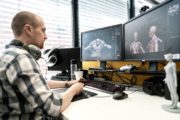
Of course, the move to flatscreen isn’t just a series of challenges – there’s also plenty of opportunity to spruce up the game for this latest version.
“In the flat-screen version, this is where those graphical effects come into play” says Ankers. “It sounds easy to say, ‘we just got some framerate back, and we banged a load of GFX at it and it looks great.’ But actually, how do we use that to build the atmosphere? How do we rebalance the lighting and create those pools of dark? It’s the same kind of language but delivered in a different way.
“Because VR is so immersive, some of the feedback that we got is that people were actually put off by being too terrified to play it. We’d never really thought of it that way before, but that is genuinely valid feedback from some players and, I think the opportunity that we had with the flat-screen version wasn’t so much to dial it down but to look for new ways to bring that in.
“So we could play a lot more with the foreshadowing, because we know roughly where the player’s looking. That plays into shadows, it plays into the reflective surfaces, that sense of tension. And then of course, audio, which plays both ways to VR and non VR, but, you know, giving you that creeping tension. A panel going and making you jump, or a creaking noise.
“So we were working on accentuating in those areas, and I think the 4K modes, and it working at 1080p on Switch really enhances so much of that that core game loop, that atmosphere, that tension – and we didn’t want to lose that at all”
“It is very much a passion project… it’s about: can we show this to more people?”
It’s obvious from the work that has gone into this latest version that The Persistence is hugely important to Firesprite. The business angle of re-releasing the game on multiple platforms is an obvious one – but talking to Ankers, it feels like more than that. The studio obviously has a lot of affection for their first IP, and this re-release feels as much of a passion project as it does a sensible business decision.
“It’s huge for us,” says Ankers. “The Persistence was our first own IP – we’re working on a lot of strategic stuff, but this is something that we can do that’s completely ours. It’s something that we’ve taken from the very kernel of the idea through to delivery.
“It’s about showing what Firesprite can do. We are very ambitious – I’ve got a big vision for the studio and where I want us to go. And we are growing quite fast. I think the game embodies what we’re about – we had to take risks with it. We had to be very efficient in how we were developing it. It’s not like we can put masses of money on marketing budgets. We had to be clever and focus on innovation of gameplay and getting that satisfying live/die/repeat loop to create something new.
“That’s always what we try to do at Firesprite. We want to try and do something that’s different. So, it’s a huge passion for us. We’re proud of the game. We’ve delivered something that was ours, with all the resources we had available to make it and bring it to market all on our own. That was actually quite ambitious for our first IP, to go into that space from nowhere.
“It is very much a passion project. It’s less about the commercial side, and more about: actually, can we show this to more people? A wider audience, that’s what it’s really about. That’s what’s driven us to do this.”
It’s easy to be cynical and say that bringing the game to TVs demonstrates that VR as a platform hasn’t delivered, either for Firesprite or for the industry. Although according to the outlook of the studio, pushing technical boundaries will continue.
“Hopefully you’ll see the same kind of message in everything that we make, that we’ll be always pushing to try and do something different – and we’ve got more of that coming soon.”

 MCV/DEVELOP News, events, research and jobs from the games industry
MCV/DEVELOP News, events, research and jobs from the games industry
